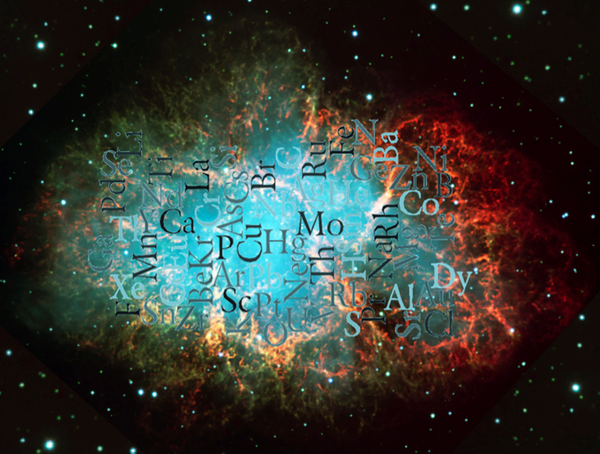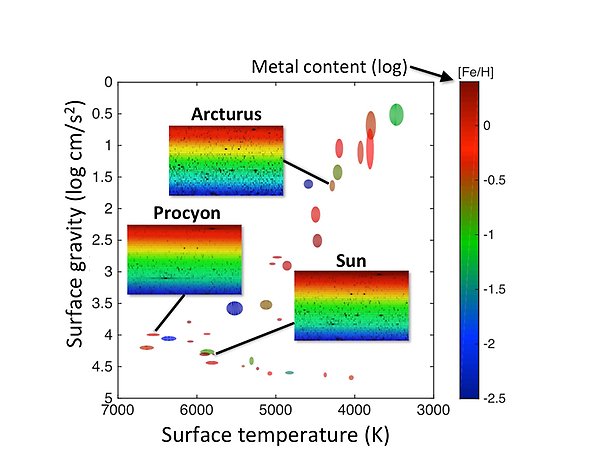Stellar composition
Metal-poor stars
Our bodies, and indeed most things on Earth, are largely made up by elements created in stars. Yet we are still far from understanding the chain of events in cosmic history that led to the elemental abundances we see today, ranging from the slow, stable nucleosynthesis in the interior of stars like the Sun, to violent core-collapse supernova explosions. The oldest and most metal-poor stars trace the events back to the very beginning.
Some 100-200 million years after its birth, the first generation of stars transformed the Universe. No primordial star made up entirely of the H, He and Li produced in the Big Bang has yet been discovered but several second generation stars with exceptionally low iron content, down to at least 1/10,000,000 of the solar value, have been found both in the Milky Way and in nearby dwarf galaxies. Most metal-poor stars in the Milky Way halo would have formed at redshifts z = 5 –10 while the recently discovered extremely metal-poor stars in the bulge may even have formed at z > 15 making them the oldest known objects in the Universe.

The remnant of a supernova is enriched in heavy elements created before and during the explosion. Image: the Crab Nebula, ESO
Researchers at the division collect and analyse high-resolution spectra of rare metal-poor stars using the world’s largest telescopes (VLT, Keck) to determine their chemical composition. The elemental abundance patterns tell us about how massive the first stars were and in which proportions heavy elements were ejected and mixed into the interstellar medium. In addition, these stars probe Big Bang nucleosynthesis, by shedding light on the elusive cosmological Li problems.
Determining the abundances is, however, particularly challenging for metal-poor stars. At low metallicity, the assumptions of 1D atmospheric models in hydrostatic and thermodynamic equilibrium are the most inaccurate, leading to systematic errors in abundances of up to an order of magnitude. With expertise in model atmosphere, radiative transfer, and atomic data calculations, astronomers in Uppsala are contributing to both observational and theoretical advances in this very active field of research.
Benchmark stars
Aldebaran, Arcturus, Pollux, Procyon, and Alpha Centauri have played a part in the culture and mythology of mankind since they were first identified and used to navigate the Earth. Astronomers used them as a reference point to describe the positions of the moon and planets as they moved through the night sky, appearing in the Babylonian Astronomical Diaries dating back to almost 1000 years BC. Now these same stars once again play a crucial role as benchmark stars. Together with thirty other stars, they are used to classify the millions of stars observed with current and future stellar surveys. They are again reference points, but this time for exploring the chemical evolution of our Milky Way.
We have established a sample of benchmark stars covering the range of F, G, and K spectral types at different metallicities, representative for a significant part of the stellar populations in our Galaxy. Stars of these spectral types are most numerous in the Galaxy – they make up more than 80% of all stars brighter than 20th magnitude according to estimations of standard Galactic models. The benchmark stars are selected to have as much information as possible available to determine their effective temperature and surface gravity independently from spectroscopy. Using measured angular diameters, bolometric fluxes and parallaxes, and masses estimated from stellar evolution models, orbital dynamics, or asteroseismology, the effective temperature is determined from the Stefan–Boltzmann relation (the surface luminosity of a star is proportional to the square of the radius and the fourth power of surface temperature), and the surface gravity from Newton's law of gravitation. We also collected high-resolution spectra of high quality to build a spectral library. These are used to determine the metal content and individual abundances of more than 20 chemical elements. For this analysis, several methods are employed and combined.

Effective temperature and surface gravity from fundamental relations for the 34 Gaia FGK Benchmark Stars. The semi-axes of the ellipses correspond to the uncertainties. Colour indicates metal content relative to the Sun on a logarithmic scale based on iron abundances measured from high-resolution spectra. Credit for the coloured spectra of Procyon, the Sun, and Arcturus: N.A. Sharp, NOAO/AURA/NSF.
The atmospheric parameters serve as a reference for testing and homogenising large ground- and space-based stellar surveys, such as the ESA mission Gaia, the European Gaia-ESO Public Spectroscopic Survey, or the Australian Large Observing Program GALAH (GALactic Archaeology with HERMES) – see also The Milky Way. With the help of the spectral library together with supplementary tools for adapting the spectra to the characteristics of different surveys it will be possible to establish a link between these large projects. This work is done in collaboration with several other research groups, primarily in Santiago (Chile) and Bordeaux (France).
The initial sample of benchmark stars is being extended to fill the parameter space with more and more stars. We participate in several observing programmes using large optical/infrared interferometers to measure stellar diameters (the ESO Very Large Telescope Interferometer on Cerro Paranal in Chile, and the CHARA Array on Mount Wilson in California).
Contact
Contact
- Head of Division
- Eric Stempels
